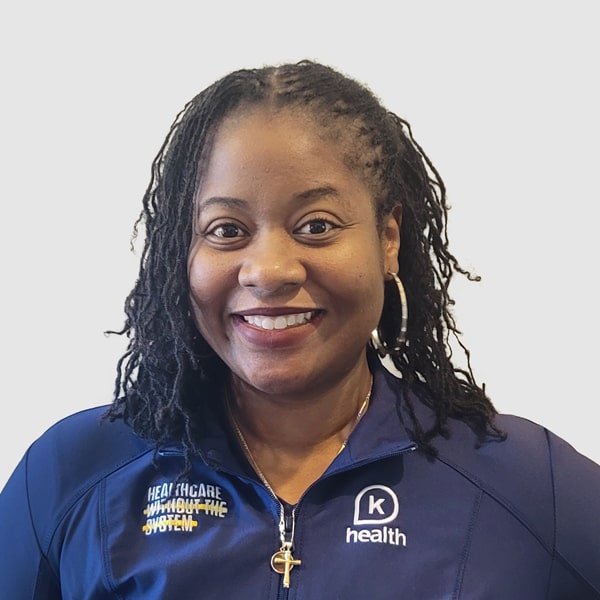Every time you see the doctor, they check your blood pressure. But you may have no idea what the numbers they rattle off mean or when you should be concerned. Understanding your blood pressure readings is a proactive and important way to look after your health.
High blood pressure (hypertension) damages the arteries, increasing the risk of coronary artery disease, heart failure, stroke, dementia, and more. Unfortunately, hypertension often causes no symptoms, so the only way to know you have it is to get checked.
In this article, I’ll explain what blood pressure is, how to test blood pressure, and what the numbers mean. I’ll also share when to see a doctor for blood pressure readings.
Manage your blood pressure at home with K health for just $29 a month.
Get StartedWhat Is Blood Pressure?
Blood pressure is the force exerted on the walls of the arteries as your blood flows through them.
It is measured using two numbers:
- Systolic blood pressure: This is the force that happens when the heart contracts and blood flows away from the heart and into the rest of the body.
- Diastolic blood pressure: This is the pressure that occurs when the heart relaxes and receives blood from the veins.
Blood pressure readings are reported in millimeters of mercury (mm Hg) and as the systolic number “over” the diastolic number, such as 120 over 80, or 120/80 mm Hg. Normal blood pressure for adults is anything below 120/80.
How to Test Blood Pressure
You can have your blood pressure tested at a doctor’s office or some pharmacies, or check it yourself at home. However it is done, the important thing is to ensure consistency in readings.
For the best results, sit calmly with your legs uncrossed, breathe normally, and refrain from talking during a reading. It’s best not to take your blood pressure within 30 minutes of exercise or exertion.
Also know that smoking, alcohol, caffeine, stress, and nerves before a blood pressure reading can all lead to a higher-than-normal result. While most people get their blood pressure tested in the left arm, it is worth getting both arms checked.
Most commonly the right arm produces higher measurements than the left arm. This is usually no cause for concern. However, if there’s more than a 10 mm Hg difference, you may be at risk of cardiovascular problems.
At the doctor’s office
When blood pressure is taken at the doctor’s office, it’s typically done as part of the intake portion of an appointment. You’ll be asked to sit still with your legs uncrossed.
A nurse or medical assistant may ask you to remove a long sleeve so that your arm is bare. They will place a cuff snugly around your upper arm. Then they’ll manually or electronically inflate the cuff.
This will cause blood to momentarily stop flowing through the artery. You should feel a gentle squeeze but no pain. Then the cuff will slowly deflate, allowing blood flow to return to normal.
The entire time, either the nurse or a machine will monitor your blood pressure. Systolic blood pressure is recorded at the first time that blood pulsing is heard when the cuff is inflated. Diastolic blood pressure is recorded as cuff deflates, once all sound of pulsing blood disappears.
If a blood pressure reading appears to be too low or too high, your healthcare provider may wait a few minutes before taking it again.
At home
You can take your own blood pressure at home using what’s called self-measured blood pressure monitoring.
Whether you’re doing this under the guidance of a doctor or you’re just curious, there are a few things to keep in mind:
- Ensure that the blood pressure cuff is the right size for your arm. A cuff that is too large or too small will lead to inaccurately high readings. The cuff should sit at least one inch above the bend of your elbow.
- Take your reading at consistent times of the day so that you can track patterns. First thing in the morning and before bed are common times to measure. If you get an abnormal reading, wait a few minutes and take it again.
- Before checking your blood pressure, empty your bladder and rest calmly for 10 minutes.
- For the reading, sit with your arms resting on a table and keep your feet and legs uncrossed.
- If you have hypertension, your doctor may ask you to take two or three readings each time to ensure that your results are accurate. In this case, take the readings at least one minute apart.
How to Read BP Numbers
Your blood pressure numbers can shed light on your risks for heart attack, stroke, and cardiovascular disease. Knowing what your blood pressure numbers mean can also help you better communicate with your healthcare provider.
Systolic
Systolic blood pressure is the first blood pressure number. It is the higher number because it is the measure of blood actively being pumped away from the heart, racing through the arteries and blood vessels to deliver oxygen and nutrients. A normal systolic blood pressure reading is less than 120 mm Hg.
Diastolic
Diastolic blood pressure is the second or bottom number in a blood pressure reading. It is the record of the pressure in the veins when blood is returning to the heart and the heart is between beats.
What the Numbers Mean
High blood pressure is called a “silent killer” because it has no symptoms. So it’s important to have your blood pressure checked and understand what your results mean. Keeping track of your blood pressure over time can help you and your doctor spot a possible problem early.
Normal range
A normal range for healthy blood pressure is below 120/80 mm Hg. You can have an occasional reading that is slightly higher without being diagnosed with high blood pressure.
If your readings are between 120/80 and 130/80, your doctor will likely note that your blood pressure is elevated and suggest some lifestyle changes to bring it down, such as dietary changes or being more active.
Hypertension
There are two stages of hypertension:
- Stage 1 hypertension is when your blood pressure readings are consistently higher than 130/80 mm Hg but lower than 140/90.
- Stage 2 is when your readings are often 140/90 or higher.
Both stages can be treated with medication and lifestyle adjustments. Your family history and other medical conditions can help your doctor determine how to treat your blood pressure.
While blood pressure is always reported as systolic and diastolic numbers, you can have high blood pressure if only one of these is high. Chronically elevated systolic blood pressure (called isolated systolic hypertension) is most common in adults 50 and older. As we age, the arteries naturally stiffen, and that leads to higher systolic blood pressure.
Hypotension
It is also possible to have blood pressure that is too low. Called hypotension, this is diagnosed when your readings are lower than 90/60 mm Hg and is often accompanied by symptoms such as lightheadedness, palpitations, or dizziness.
Hypotension may occur for many reasons, but blood loss, low blood sugar, and even diabetes are common causes.
Manage your blood pressure at home with K health for just $29 a month.
Get StartedWhen to See a Doctor
Concerning changes in blood pressure does not always produce symptoms, so any time you experience changes to your health, check in with your healthcare provider.
Headaches or feeling a pulsing sensation in your head or throughout your body may be indicative of high blood pressure. On the other hand, feeling lightheaded or dizzy or passing out may be signs of low blood pressure.
If you monitor your blood pressure at home or get it checked at a pharmacy, check in with your doctor if your levels are elevated more than once in a short period of time. And if you have a family history of high blood pressure, having your doctor regularly assess your blood pressure can be a proactive way to support good health.
How K Health Can Help
K Health offers affordable and convenient access to highly qualified doctors to treat and manage high blood pressure, as long as you are not having a hypertensive crisis.
You can meet with your K Health doctor from the comfort of your own home via the K Health app, all while knowing that you’re getting individualized and expert care.
Frequently Asked Questions
K Health has strict sourcing guidelines and relies on peer-reviewed studies, academic research institutions, and medical associations. We avoid using tertiary references.
-
Accurate Blood Pressure Measurements and the Other Arm. (2013).
https://www.ncbi.nlm.nih.gov/pmc/articles/PMC3709227/ -
Blood Pressure and Ageing. (2007).
https://www.ncbi.nlm.nih.gov/pmc/articles/PMC2805932/ -
Blood Pressure Measurement. (2020).
https://medlineplus.gov/ency/article/007490.htm -
High Blood Pressure. (2018).
https://www.nia.nih.gov/health/high-blood-pressure -
High Blood Pressure Symptoms and Causes. (2021).
https://www.cdc.gov/bloodpressure/about.htm -
Low Blood Pressure. (n.d.).
https://www.nhlbi.nih.gov/health-topics/low-blood-pressure -
Measure Your Blood Pressure. (2021).
https://www.cdc.gov/bloodpressure/measure.htm -
Tips to Measure Your Blood Pressure Correctly. (2019).
https://www.health.harvard.edu/heart-health/tips-to-measure-your-blood-pressure-correctly -
What Is Blood Pressure and How Is It Measured? (2010).
https://www.ncbi.nlm.nih.gov/books/NBK279251/

 Medically reviewed
Medically reviewed
